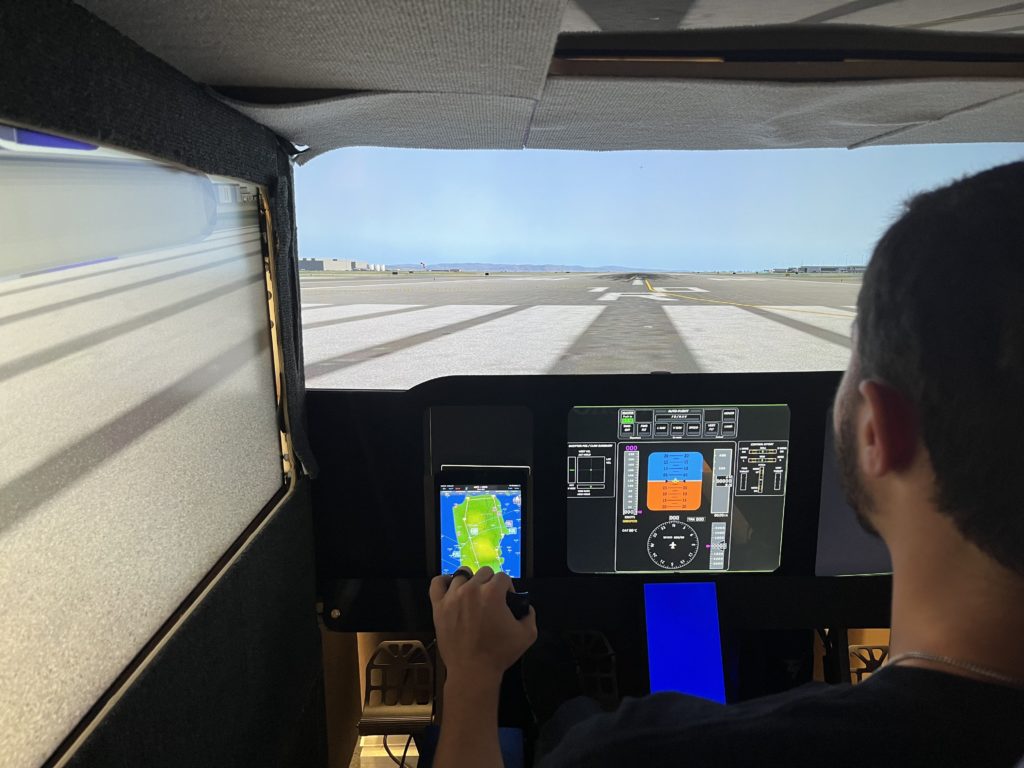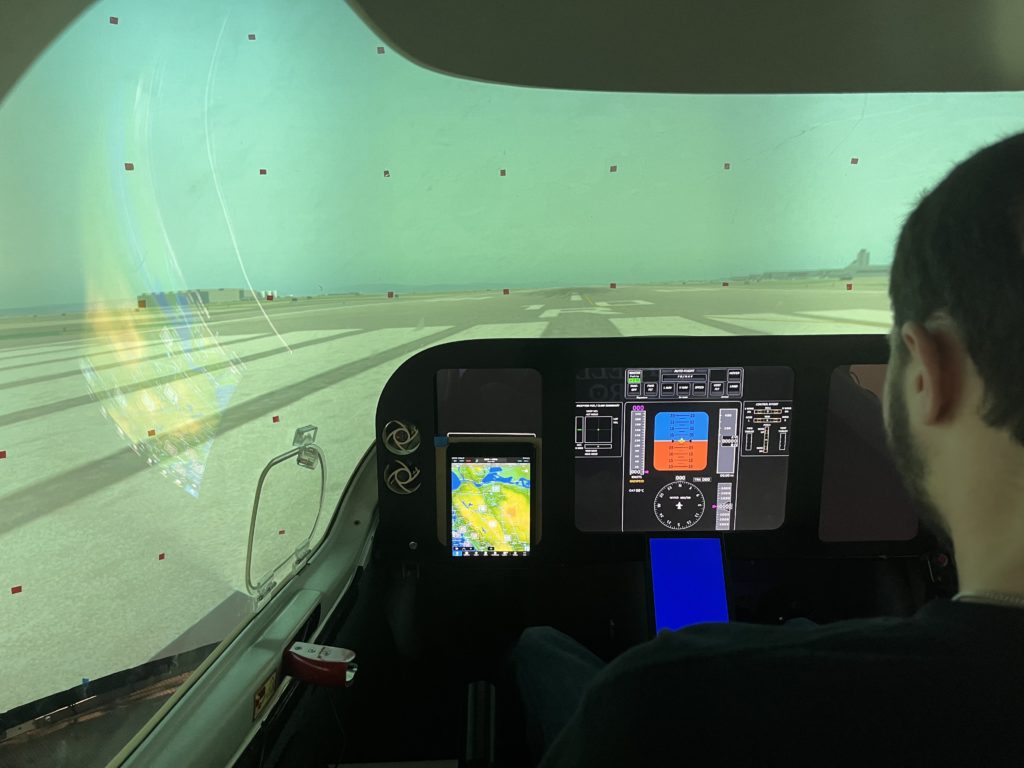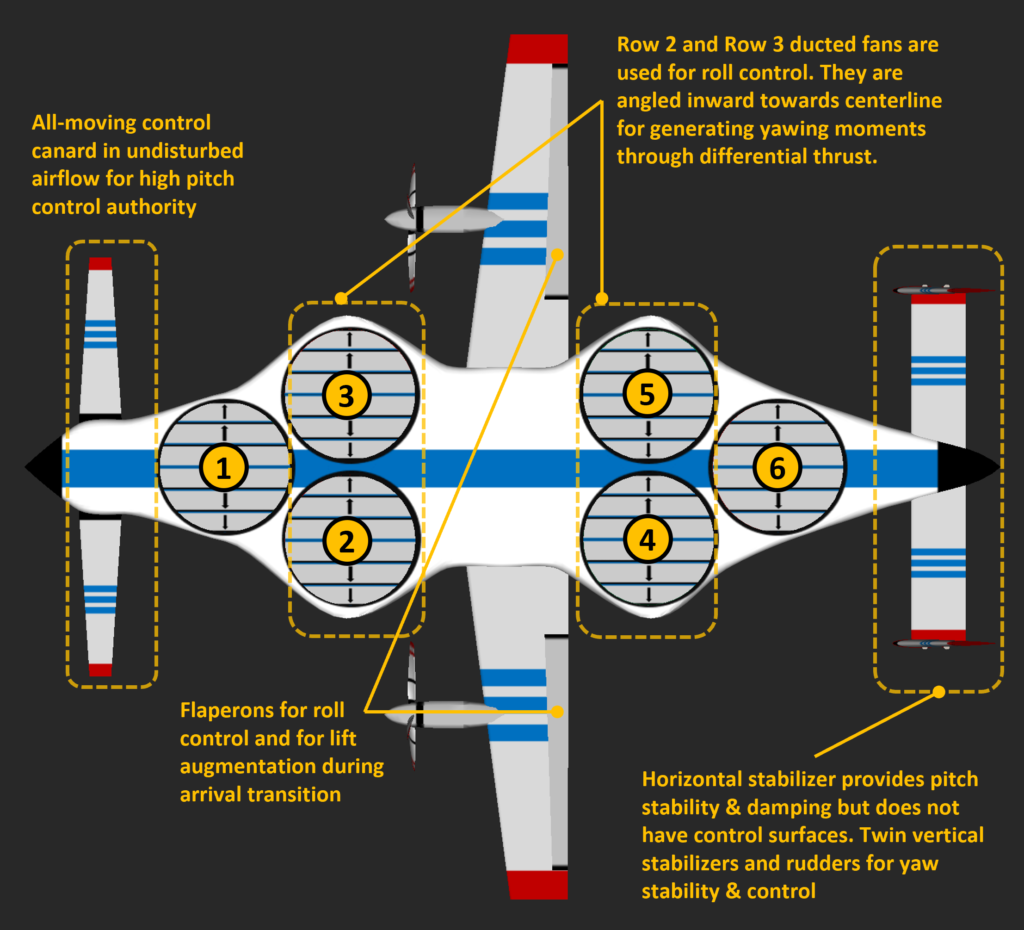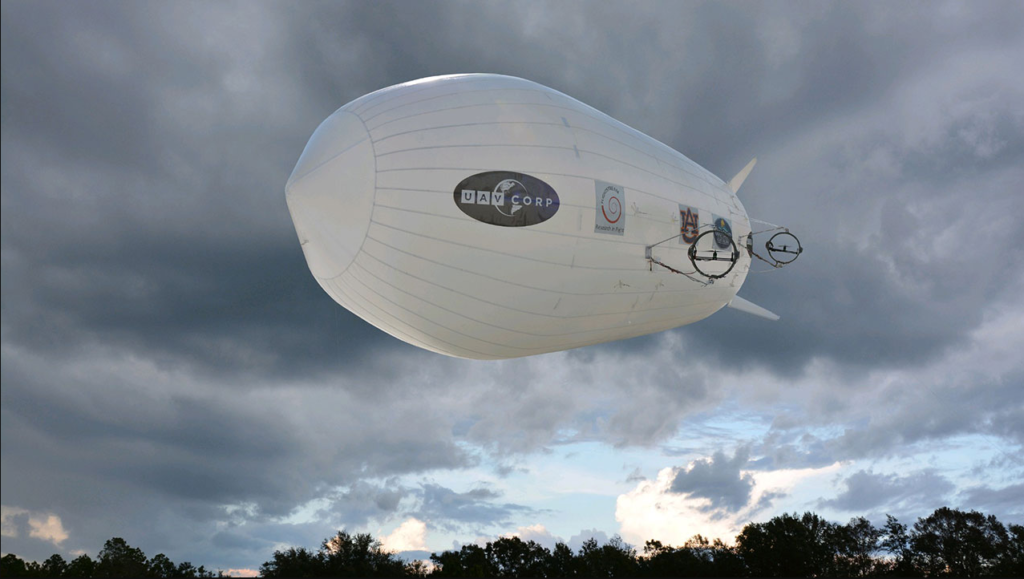Active Projects
Flight Simulation-Driven Research into Simplified Vehicle Operations for Urban Air Mobility
Sponsor: Federal Aviation Administration (FAA)
Duration: Aug 18, 2021 – Oct 17, 2022 (active)
Principal Investigator: Dr. Imon Chakraborty
This project has four main objectives. The first is to investigate the design of pilot-friendly flight control systems that facilitate the Simplified Vehicle Operations (SVO) paradigm. The second is to develop streamlined cockpit displays that convey relevant information to the UAM pilot without causing information overload. The third is to assess multiple inceptor designs and inceptor-to-command mappings. The fourth is to assess how prior piloting experience (or lack thereof) impacts performance on representative UAM piloting tasks. Flight Simulator #1 (Sim 1) and #3 (Sim 3) will be used to support this project.
Related publications:
* McAdory, J., “Aerospace professor, students, awarded funds from FAA for research,” Auburn University College of Engineering website, Dec 13, 2021 (Link to article)

Sim 1 with airplane-centric setup 
Sim 3 with helicopter-centric setup
Use of Pilot Models to Support Design, Analysis & Certification of UAM Vehicles
Sponsor: NASA Armstrong Flight Research Center
Duration: July 20, 2021 – July 19, 2023 (active)
Performing entities: Systems Technology Inc. (prime contractor), Auburn University (sub-contractor)
Information coming soon!
Air Vehicle Gust Response Analysis for Early Design
Sponsor: NASA Ames Research Center
Duration: Phase I 2019-2020 (Completed); Phase II 2021-2023 (Active)
Collaborators: Dr. Vivek Ahuja (Research in Flight), Prof. Roy Hartfield (Research in Flight)
This STTR project funded by NASA Ames Research Center aims to develop simulation and analysis capabilities for gust encounters and gust load alleviation for distributed electric propulsion (DEP) enabled urban air mobility (UAM) concepts.
Phase I resulted in the development of Controls and Load Alleviation Simulation Platform (CLASP), a MATLAB/Simulink based framework for simulating gust/turbulence encounters, gust load alleviation algorithms, and structural dynamics. Initial proof-of-concept gust encounter simulations were demonstrated for the NASA LA-8 concept in forward flight mode. Phase II will focus on extending these capabilities to vertical flight mode and enhancing the fidelity of the simulations.
Collaborative Flight Data Driven General Aviation Safety Research
Sponsor: Auburn University Intramural Grants Program (IGP)
Status: Active
Collaborator: Dr. Steve Swartz (Department of Aviation)
The goal of this project is to conduct research using real-world flight data to model General Aviation (GA) aircraft performance, analyze safety of flight retro-actively, and eventually enhance flight safety pro-actively in real-time.
The project is supported by Auburn University’s Intramural Grants Program (IGP) and is a collaborative effort with the Department of Aviation. Its fleet of Garmin G1000-equipped Cessna 172 aircraft, which operate out of Auburn University Regional Airport (KAUO), will be used to collect flight data for calibrating and validating developed models and algorithms. The end goal is to develop safety advisory tools capable of running real-time on portable electronic devices that can be carried into the cockpits of even older aircraft with limited instrumentation and little or no data collection capability.
Generalized Energy-Based Aircraft Sizing and Mission Performance Analysis
Sponsor: Initially funded by AU Intramural Grants Program (IGP); currently funded as Internal Research and Development (IRAD)
Duration: Mar 2019 – (active)
The original goal of this project was to develop a generalized energy-based aircraft sizing and mission analysis framework capable of handling air vehicles employing wing-borne, rotor-borne, or buoyant lift or a combination thereof, as well as all-electric, hybrid-electric, and conventional fuel-consuming propulsion system architectures. This goal was realized with the successful development of the Parametric Energy-based Aircraft Configuration Evaluator (PEACE). The PEACE framework features a parametric geometry definition of the aircraft, explicit trim solutions for both mission analysis and power sizing, a resizing rule-set governing updates of the aircraft geometry and characteristics during sizing, and the ability to incorporate a wide range of aero-propulsive modeling approaches.
Related publications:
* Chakraborty, I., Miller, N.S., and Mishra, A.A., “Sizing and Analysis of a Tilt-Wing Aircraft with All-Electric and Hybrid-Electric Propulsion Systems,” AIAA SCITECH 2022 Forum, Jan 3-7, 2022, San Diego CA and virtual, AIAA-2022-1515
* Chakraborty, I., Mishra, A.A., Miller, N.S., van Dommelen, D., and Anemaat, W.A., “Design and Sizing of a Dual-Purpose Hybrid-Electric Ducted Fan Lift-Plus-Cruise Aircraft,” AIAA SCITECH 2022 Forum, Jan 3-7, 2022, San Diego CA and virtual, AIAA-2022-1516
* Chakraborty, I. and Mishra, A.A., “Generalized Energy-Based Flight Vehicle Sizing and Performance Analysis Methodology,” AIAA Journal of Aircraft, Vol. 58, No. 4, pp 762-780, July-Aug 2021, doi: 10.2514/1.C036101
* Chakraborty, I. and Mishra, A.A., “A Generalized Energy-Based Vehicle Sizing and Performance Analysis Methodology,” AIAA SCITECH 2021 Forum, Jan 11-15 and 19-21, 2021 (virtual event), AIAA-2021-1721
Past/Concluded Projects
Modular Generalized Framework for Assessing Aircraft Aero-Propulsive, Stability, and Control Characteristics
Sponsor: NASA Langley Research Center
Duration: Jan 2019 – Dec 2021 (concluded)
Collaborators: Dr. Vivek Ahuja (Research in Flight), Prof. Roy Hartfield (Auburn University)
This three-year project was funded by NASA Langley Research Center under the Transformational Tools and Technologies (TTT) Project. It was VSDDL’s first externally funded research project. The project was aimed at developing tools, processes, and methods to assess and evaluate stability and control characteristics of unconventional aircraft configurations during the early design stage.
The project resulted in the development of Modular Aircraft Dynamics and Control Algorithm Simulation Platform (MADCASP), a MATLAB/Simulink based aircraft and control systems simulation platform. MADCASP has been used to analyze trimming, stability and control characteristics, and flight control architectures for both conventional and unconventional aircraft designs. Additionally, MADCASP is used in real-time mode to drive each of the VSDDL flight simulators. The YouTube video below demonstrates a piloted simulation of the NASA LA-8 tandem tilt-wing e-VTOL configuration. The flight dynamics and flight control system architecture were modeled using MADCASP and simulated in real-time on a VSDDL flight simulator.
Related publications:
* Chakraborty, I., Mishra, A.A., Comer, A., and Leonard, C., “Total Energy Based Flight Control System Design for a Lift-Plus-Cruise Urban Air Mobility Concept,” AIAA SCITECH 2021 Forum (virtual event), Jan 11-15 and 19-21, 2021, AIAA-2021-1899
* Chakraborty, I., Leonard, C., Comer, A., Mishra, A., and Dewey, J., “A Reconfigurable Flight Simulation Framework aimed at Novel Flight Vehicle Concepts,” AIAA AVIATION 2020 Forum (virtual event), June 15-19, 2020, AIAA-2020-3190
* Chakraborty, I., Comer, A., and Dewey, J., “A Simulation-Based Aircraft-Centric Assessment of the Circular/Endless Runway Concept,” AIAA SCITECH 2020 Forum, Orlando, FL, January 6-10, 2020, AIAA-2020-1401
* Chakraborty, I., Ahuja, V., Comer, A., and Mulekar, O., “Development of a Modeling, Flight Simulation, and Control Analysis Capability for Novel Vehicle Configurations,” AIAA AVIATION 2019 Conference, Dallas, TX, June 17-21, 2019, AIAA-2019-3112
using MADCASP to drive VSDDL Flight Simulator #3 (Sim 3) in real-time
Dual-Use UAM e-VTOL Aircraft – Design, Analysis and Testing Capabilities
Sponsor: United States Air Force Agility Prime Program
Duration: 2021 (concluded)
Performing entities: DARcorporation (SBC) and Auburn University (RI)
Leadership: Dr. Willem Anemaat, DARcorporation (overall PI); Dr. Imon Chakraborty (Auburn University PI)
This project involved sizing studies, performance analysis, and simulation model development for a dual-use Urban Air Mobility (UAM) lift-plus-cruise aircraft that featured six ducted fan lift propulsors and two wing-mounted cruise propulsors. The sizing studies were conducted using VSDDL’s Parametric Energy-based Aircraft Configuration Evaluator (PEACE) framework, and considered both all-electric and hybrid-electric propulsion systems across a range of battery technology levels (energy densities). The simulation and flight control system models were developed using MADCASP, and feature Total Energy Control System (TECS) and Total Heading Control System (THCS) flight control schemes. Further details about DUeVTOL are available under the “Hangar” page. The general DUeVTOL configuration is shown below.
Related publications:
* Chakraborty, I., Mishra, A.A., Miller, N.S., van Dommelen, D., and Anemaat, W.A., “Design and Sizing of a Dual-Purpose Hybrid-Electric Ducted Fan Lift-Plus-Cruise Aircraft,” AIAA SCITECH 2022 Forum, Jan 3-7, 2022, San Diego CA and virtual, AIAA-2022-1516
* Montgomery, C., “Aerospace faculty member part of six Air Force Agility Prime awards,” Auburn University College of Engineering website, April 30, 2021 (Link to article)

A Revolutionary Dual-Use AAM VTOL Designed for Simplified Vehicle Operation
Sponsor: United States Air Force Agility Prime Program
Duration: 2021 (concluded)
Performing entities: Transcend Air Corporation (SBC) and Auburn University (RI)
Leadership: Mr. Peter Schmidt, Transcend Air Corporation (overall PI), Dr. Imon Chakraborty (Auburn University PI)
The goal of this project was to demonstrate the Simplified Vehicle Operations (SVO) philosophy for the Transcend Air Corporation Vy 400 tilt-wing concept. A SVO-centric flight control system architecture was developed at VSDDL, interfaced with an X-Plane based flight simulation model of the Vy 400, and deployed on Flight Simulator #3 (Sim 3).
Related publications:
* Business Wire, “Transcend Air Awarded Key Air Force Project to Develop Simplified Vehicle Operation and High Speed Nap of the Earth VTOL Flight,” April 5, 2021 (Link to article)
* Montgomery, C., “Aerospace faculty member part of six Air Force Agility Prime awards,” Auburn University College of Engineering website, April 30, 2021 (Link to article)
Simplified Vehicle Operations (SVO) flight control architecture in VSDDL Flight Simulator #3 (Sim 3)
Electric Extended Range Airship with Modular Payload
Sponsor: United States Air Force Agility Prime Program
Duration: 2021 (concluded)
Performing entities: Research in Flight (SBC), Skyborne Technology Inc. (SBC), and Auburn University (RI)
Leadership: Dr. Vivek Ahuja, Research in Flight (overall PI); Dr. Imon Chakraborty (Auburn University PI), Dr. Ehsan Taheri (Auburn University)
The goal of this project was to design, implement, and test propulsion and flight control systems for a 40-foot long airship, which would serve as a demonstrator and test bed for a larger full-scale vehicle. Auburn University was responsible for the design and implementation of the propulsion control system that controlled the subscale airship’s four gimballed propulsors. The project concluded with a successful flight demonstration at Skyborne’s facility in Wewahitchka, FL on September 29, 2021.
Related publications:
* McAdory, J., “Aerospace professors successfully partner with U.S. Air Force Agility Prime Program,” Auburn University College of Engineering website, Jan 12, 2022 (Link to article)
* Montgomery, C., “Aerospace faculty member part of six Air Force Agility Prime awards,” Auburn University College of Engineering website, April 30, 2021 (Link to article)

Active Landing Gear for Advanced Air Mobility: Delivering a Safe, Simple and Virtually Silent Aircraft Without the Runway
Sponsor: United States Air Force Agility Prime Program
Duration: 2021 (concluded)
Performing entities: Metro Hop (SBC), and Auburn University (RI)
Leadership: Mr. Bruno Mombrinie, Metro Hop (overall PI); Dr. Imon Chakraborty (Auburn University PI)
The goal of this project was to develop simulation models to assess the takeoff and landing operations of the Metro Hop aircraft and its novel Active Landing Gear concept. VSDDL developed kinematic and dynamic models of the landing gear, which were incorporated into MADCASP along with an aero-propulsive and flight control system models for the aircraft. MADCASP was then used to perform takeoff and landing simulations while varying a range of parameters of interest.
Related publications:
* Tegler, E., “Active Landing Gear That Launch An Airplane Like A Bird Caught The Air Force’s Attention”, Forbes Aerospace & Defense, April 2, 2021 (Link to article)
* Montgomery, C., “Aerospace faculty member part of six Air Force Agility Prime awards,” Auburn University College of Engineering website, April 30, 2021 (Link to article)
An Agile, Adaptive Flight Research Simulator for Dual-Use Military and Urban Air Mobility Aircraft Development
Sponsor: United States Air Force Agility Prime Program
Duration: 2021 (concluded)
Performing entities: Avilution (SBC) and Auburn University (RI)
Leadership: Mr. Mark Spencer, Avilution (overall PI); Dr. Imon Chakraborty (Auburn University PI)
The goal of this project was to integrate Avilution’s eXtensible Flight System (XFS) software into the systems architecture of VSDDL’s flight simulators to develop, demonstrate, and commercialize a unique XFS-integrated capability suite that enables Simplified Vehicle Operations (SVO) for revolutionary, next-generation flight vehicles through simplified cockpit displays and synoptics. The integration was demonstrated using VSDDL Flight Simulator #3 (Sim 3) during this Phase I STTR project.
Related publications:
* Boos, A., “Avilution Partners with Auburn University on Agility Prime STTR”, Avilution website, Nov 17, 2020 (Link to article)
* Montgomery, C., “Aerospace faculty member part of six Air Force Agility Prime awards,” Auburn University College of Engineering website, April 30, 2021 (Link to article)
Electric Scalable Aerial Transport – Benefits of a Helicopter at the Cost of Ground Transportation
Sponsor: United States Air Force Agility Prime Program
Duration: 2021 (concluded)
Performing entities: Research in Flight (SBC), Blueflite (SBC), and Auburn University (RI)
Leadership: Dr. Vivek Ahuja, Research in Flight (overall PI); Dr. Imon Chakraborty (Auburn University PI)
The goals of this project were to perform multi-mission sizing and performance analyses for the novel Blueflite (formerly Flugauto) VTOL aircraft concept to demonstrate its dual-use potential and to develop flight simulation models to enable piloted simulation of this concept for manned/human transport missions.
Related publications:
* “AFWERX supported electric scalable aerial transport project launched “, sUAS News, February 24, 2021 (Link to article)
* Montgomery, C., “Aerospace faculty member part of six Air Force Agility Prime awards,” Auburn University College of Engineering website, April 30, 2021 (Link to article)
